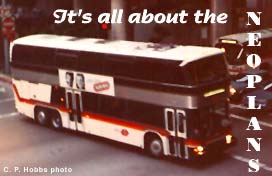 And you thought that double-decker
buses were only in London...
And you thought that double-decker
buses were only in London...
I first started riding Los Angeles public transit in Summer 1984.
After a month or so, I noticed that some of the buses were...uh
"better" than others. There were plenty of older buses that RTD
was hanging on to during the Olympics, and a few not-so-great
models from the 70's. Then there were the General Motors RTS's
with the rattling windows.
And then there were the Neoplans. RTD had purchased 415
of them (all regular, single level, 40-footers) in early 1984,
in anticipation of the Olympics. Most of these ended up in
the San Fernando Valley, so when they occasionally ended up on
a San Gabriel Valley route, it was a real improvement over the
older buses (AM Generals mostly) that usually ran out there.
They had smooth-running motors, working air conditioning, and
a new-car (ok, new-bus) smell.
|
Nothing could compare, though, to a ride on one of RTD's Neoplan double decks.
RTD had purchased two of these vehicles in 1975 as part of a
demonstration project. In 1981, they purchased an additional 20 of these buses, making
the largest double deck public bus fleet in the U.S.. However, I wasn't aware of them until mid-1984.
In August 1984, I was waiting at Alosta and Grand in Glendora
for a local bus when I saw the double deck #498
I finally got to ride one in September 1984. Although I had ridden public
transit many times before, this was my first trip on a public bus to
Downtown LA. I had planned to ride #498 into Downtown LA, hang around there
for awhile, then continue on Line #40 to Downtown Inglewood.
So, I waited at Grand and Alosta, until the double deck bus pulled up.
I flashed my $4 student pass, and made my way upstairs. I noticed that
the stairs were very steep, more so than normal stairs, and in fact
a red sign on them said "Warning--High Risers". On the second deck,
several similar red signs warned passengers of "low headroom". In fact
the seats at the very front of the upper deck had "low legroom" as well, in
order to make space for entering passengers and the driver.
The lower deck, while it had fewer seats than a regular bus, did feature
tables and "luggage racks" (in that hard-to-use space over the front
wheels, since the buses were actually designed to have a low-floor).
|

|
- Manufacturer: Neoplan,
West Germany
- Model: 122/3
- Length: 40 feet
- Width: 8.5 feet
- Height: 14 feet
- Cost: $225,000
- Seating: 28 seats lower deck
54 seats upper deck
82 total seats
|
As the bus drove south along Grand, we were about to pass under the I-210 freeway
overpass. I thought "Uh, oh, are we going to make it?" But of course we did. While
riding, Eventually, we arrived at the Eastland Center park-and-ride
lot, where the bus got so full that people were sitting on the stairs. Then
it was the I-10 freeway and the El Monte Busway, zipping past traffic. We made the
stops at Cal State LA, and at the County Hospital, then back onto the freeway for
the trip into Downtown LA. I got off at Spring and First and continued my adventure.
So from then on, and throughout 1985, and until January 1986, my idea of a great transit adventure
usually started like this:

- Wait at Grand and Alosta
- Board Line #498
- Ride to Downtown L.A.
- Connect with a bus route going elsewhere (Usually, to places like
Torrance, Long Beach, Santa Monica or Orange County, but once I rode
all the way to San Diego County, using public buses).
- Ride #498 back home. (Once I tried #495 to Hacienda Heights and
transferred to #280 on Azusa. It was a longer trip)
#498 was also fun to ride on trips home from Santa Barbara; get off
the Greyhound in LA, walk outside to an RTD #48 stop (or just
walk up to Flower St), then catch the #498.
#495 and #498 were almost always guaranteed to have the double deck
buses. (There were rumors that they were occasionally placed on other
San Gabriel Valley express routes, but I never saw them on any other
line but #495 and #498). Occasionally, however one or more would be in
the shop, and we'd be stuck with one of
the older buses. One driver commented "The double decker was low on oil,
they'll put gas in them but not oil in them".
1986:
In February 1986, I was up in Santa Barbara, reading the L.A. Times
one morning. There was an article in the paper, saying that "RTD might
get rid of the double deck buses". In the article, there were the usual
worries of buses hitting trees and breaking the windshield (known to
happen) and possibly hitting a low bridge (never happened to my knowledge).
But that article didn't tell half the truth about what really happened...
Going home to L.A, on break, I noticed that all the #498's were single deck
buses. An article in the local Pomona paper described a fire in the bus
yard that had totally destroyed two of the double decks, and one other bus. Later
on it had been determined that the fire was caused by faulty wiring in
one of the double decks (and not arson, as originally thought). On a quick
trip by the bus yard, I saw one of the burnt-out buses, with all its windows
melted out. A bus driver on the #498 said, "They'll never run again."
But the buses were to run again, they were just out of service for about
a year so that their electrical systems could be checked out and
updated.
1989: The return of the double decks
 Eighteen of the double deckers (minus the two burnt-up ones, and the 1975 demonstrators, which
had been retired)
returned to the streets of Southern California in Fall 1988.
Now they almost exclusively operated on Route #495 until
Foothill Transit took
over that route in early 1989. (Foothill had already taken over #498)
After that, they were used on Line #497 (LA-Pomona)
Eighteen of the double deckers (minus the two burnt-up ones, and the 1975 demonstrators, which
had been retired)
returned to the streets of Southern California in Fall 1988.
Now they almost exclusively operated on Route #495 until
Foothill Transit took
over that route in early 1989. (Foothill had already taken over #498)
After that, they were used on Line #497 (LA-Pomona)
Line #497 presented problems that #498 and #495 did not. Problem Number 1 was
Kellogg Hill (on I-10 between West Covina and Pomona). Especially going eastbound,
buses had difficulty climbing the hill. 18-wheeler trucks would pass the buses.
That's slow!
There was also about 15-20 minutes of street running on #497 (along Wilshire Blvd from
Downtown LA to Wilshire/Western). That was a pretty scenic ride, but since the buses
didn't handle local passengers along Wilshire, anyone wanting to take it would have
to travel to/from Pomona. (There were other buses that operated between LA and Pomona,
all day and all night, though. In fact, for a short while in 1992, #497 operated
bidirectional peak hour service, so someone could board a double decker in LA in
the morning, then ride back before noon. Or, board in Pomona in the afternoon, and
ride back from L.A. that same night).
1994: Last Ride of the 9900's
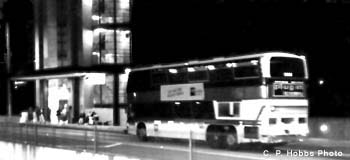 By 1994 these buses were 13 years old--about one year past
"retirement age" according to the transit agency.
By 1994 these buses were 13 years old--about one year past
"retirement age" according to the transit agency.
Also, Line #497,
where these buses were exclusively used,
was slowly but steadily losing ridership to this newfangled thing
called Metrolink...
So after December 1994, all of the remaining double deck fleet was
put out of service. For about a year, they lingered at the
RTD yard just east of Downtown. Then they were sold to
Chicago Motor Coach
for use in their tourist service around Chicago. (The upper
deck roof and windows have been removed, so they are now
open-air buses). They advertise a "fleet of historic English and
modern German double decker buses". Yes, those were L.A.'s
"largest doubledeck public bus fleet", alright, painted red...
I saw a couple of the buses in my 1998 visit to Chicago, but
two years later, the buses seemed to have disappeared. I looked
for them at their usual stops--Sears Tower, Navy Pier, Michigan
Avenue--not one to be found. The old Chicago Motor Coach yard
(Madison and Halstead) was being torn up for another project,
and their website (http://www.chicagomotorcoach.com) no longer
worked...
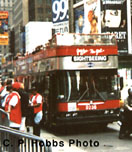
|
The mystery of "what happened to the buses" was solved when
I arrived in New York a few days later. Gray Line of New
York had bought the buses and was using them in sightseeing
service in New York City! What a 3000-mile journey...from the
L.A. freeways to the crowded streets of Manhattan!
|
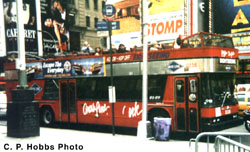
|
The Double Decks Ride Again
In 1994, as MTA was phasing out its double decks,
the Antelope Valley Transit Authority (
AVTA) had a capacity problem on its
Lancaster-Los Angeles commuter route. So it ordered three double deck
buses from Neoplan USA in Lamar, Colorado. The buses hit the streets in
August 1996.
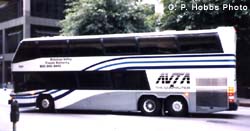
These buses are superficially similar to those formerly owned and
operated by RTD/MTA, but with a few differences:
- made in the USA (Colorado)
- fewer seats (but they recline!)
- a handicapped lift in the back door
- a restroom (also handicapped accessible)
Two round trips (to L.A. in the morning and to Lancaster in the
evening) are operated with these buses, leaving the third as a spare.
I haven't ridden these yet, due to the need for an overnight stay
in Lancaster. But I might...and when I do, the trip report will
be right here at this page!
Blue Cafe|Home Page

 And you thought that double-decker
buses were only in London...
And you thought that double-decker
buses were only in London...

 Eighteen of the double deckers (minus the two burnt-up ones, and the 1975 demonstrators, which
had been retired)
returned to the streets of Southern California in Fall 1988.
Now they almost exclusively operated on Route #495 until
Foothill Transit took
over that route in early 1989. (Foothill had already taken over #498)
After that, they were used on Line #497 (LA-Pomona)
Eighteen of the double deckers (minus the two burnt-up ones, and the 1975 demonstrators, which
had been retired)
returned to the streets of Southern California in Fall 1988.
Now they almost exclusively operated on Route #495 until
Foothill Transit took
over that route in early 1989. (Foothill had already taken over #498)
After that, they were used on Line #497 (LA-Pomona)
 By 1994 these buses were 13 years old--about one year past
"retirement age" according to the transit agency.
By 1994 these buses were 13 years old--about one year past
"retirement age" according to the transit agency.


